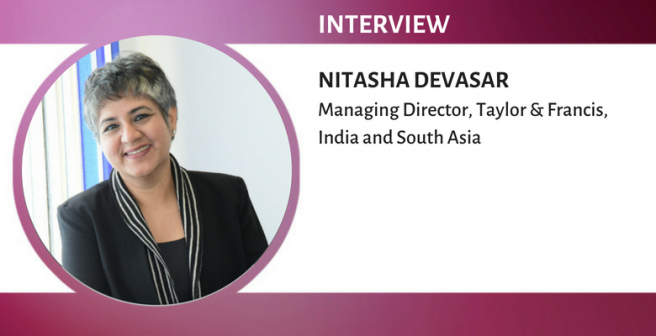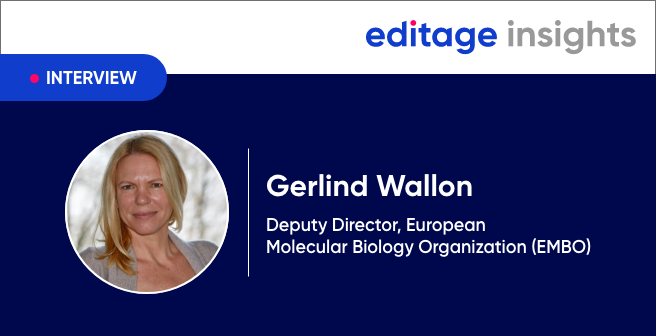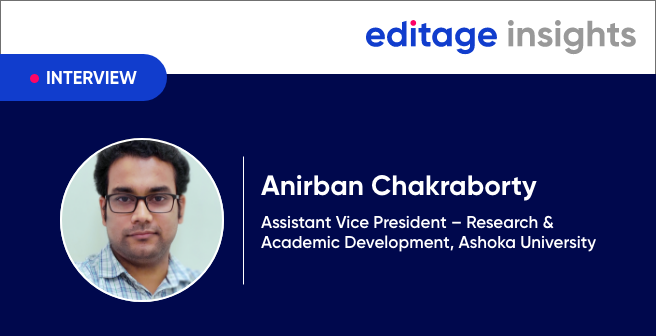Content, data, and geography are together transfiguring the academic publishing universe-Nitasha Devasar

Nitasha Devasar is Managing Director, Taylor & Francis, India and South Asia. Nitasha has considerable experience in academic publishing and a keen understanding of the dynamic Asian academic publishing marketplace. Her current focus is on business development and content acquisition from India and South Asia for the global markets. She has also been involved in the creation of India’s first full-time course on publishing. Prior to joining Taylor & Francis, she was Academic Publishing Director at Oxford University Press India for 12 years. During this period, she published over 2000 academic books that contributed substantively to scholarship on South Asia.
She has several industry affiliations: Vice President of the Association of Publishers in India; Member of the FICCI Publishing Committee and Adviser with the Women Leadership Forum of Asia. She is part of the Taylor & Francis Group Women in Leadership Program and was also lauded as Channel News Asia’s Women of Substance in Asia in 2017.
In 2012 she set up a publishing consultancy, PublishInc., to partner with academic societies, research institutes, universities, and government agencies to help them implement effective research outreach methods. Nitasha holds an MA and MPhil in Applied Economics from Jawaharlal Nehru University, New Delhi, India.
Her edited book Publishers on Publishing: Inside India’s Book Business., has just been published. She also frequently contributes to The Hindu and her blog posts on various management and leadership-related issues can be seen in various periodicals. She occasionally lectures on the changing publishing landscape in India at management schools and universities.
In this conversation Nitasha talks about the global academic book publishing space. She shares her views on aspects such as challenges in the publishing industry, the role of publishers, and the author-publisher relationship. She also talks about how Indian authors can increase their visibility on the global publishing stage.
You’ve mentioned that you ventured into publishing accidentally and “it was love at first sight.” This has an interesting ring to it. Could you share your story with our readers?
As a young researcher who didn’t want to teach and eventually found research too ivory tower and isolating, I was pretty much headed towards an uncertain and unemployed future when I happened to attend a conference that was located close to the publishing offices of a social sciences publisher. I dropped by to ask for freelance work and was asked to do an editing test. I spent an extremely engaged hour trawling through an academic piece to make it accessible and realized I had found something to do with academia that I would enjoy. My instinct proved right and the combination of the creative and commercial that engagement with academic content has been, keeps me learning and engrossed even after two decades!
You were involved in setting up India’s first full-time teaching course in publishing. Could you tell us more about this?
I learnt publishing on the job and continue to do so every day, after stumbling into the profession. There are many like me, but there are also many who attend short-term editing and marketing courses to qualify to enter the profession. When I was asked a few years ago by a relatively new university in Delhi to do the groundwork for setting up a full-time comprehensive publishing course, I finally had the opportunity to explore this from the other side. More importantly, it seemed like an ideal way to get trained professionals into the industry where the hiring of suitable people has been tough. The ideal publishing course, I felt, would need to be well rounded, forward looking, have industry professionals as instructors and ultimately help the graduates that emerged get absorbed into the publishing industry—a tall order and one which has only been partially achieved so far. A new book I have just edited, Publishers on Publishing: Inside India’s Book Business, with contributions from 65 professionals from in and around publishing, is another step towards creating professional content for such courses.
What, in your view, are some of the most significant developments in the global academic book publishing space?
Technology has transformed and continues to transform academic publishing by putting users at the forefront of the process and providing scope for continual value addition. First it was book production that became faster, flexible and eventually cheaper. Then it was delivery with the advent of online stores. Next it was the change in the publishing process itself as well as the changes in the way in which readers access information, with the introduction of newer digital tools and platforms. It is safe to say that the publishing system and process continue to transform, adding more functionalities and flexibility and becoming increasingly bespoke to users. Today, as the boundaries between content and platforms are disappearing, we are seeing transformation in the arena of services. We are witnessing a lot of dynamic changes—variety in formats, the splicing and dicing of content to aid continuous learning, translation on tap, testing applications, audio, and video, and much more! The arena of action has simultaneously shifted from the mature markets of the Western world to this side of the globe, throwing countries like China and India into focus. Thus some longstanding rules of the game are changing. Content, data and geography are together transfiguring the academic publishing universe.
What role do you think libraries play in today’s dynamic academic publishing scenario?
Libraries are transforming into spaces of engagement from being just repositories. They can be dynamic instruments and hubs of education and not merely reading rooms. In India, they are the conduit through which researchers can get access to global research in academic journals and books as well as other media.
If used effectively, for researchers, they can be powerful virtual spaces to engage with peers, seniors and publishers in their area of research. This can support both access to quality artifacts and to training and support for publication and visibility, all of which are so vital to all researchers, even in an Open Access and Open Scholarship world.
How has the role of academic publisher evolved over the years? Also, how has the author-publisher relationship evolved?
The publisher’s role has changed from being a product creator, giving shape and form to raw manuscripts derived from the author, to a service facilitator who not only provides the curation, framing and amplification for books and journal articles (in several formats), but goes much further to ensure visibility and accessibility to the target audience. This is then fed back into the system for demand-driven, bespoke content curation which is completely different from the traditional supply-push mindset of academic publishing.
There is certainly something enduring and timeless in the author-publisher relationship that arises from the intimacy of creating a journal article or book (or value) together. It is a valuable relationship which now needs to be nurtured through services well beyond the publication of a book or article and requires creating digital footprints to connect readers and authors for the benefit of both.
In the introduction to your book, Publishers on Publishing, you mention that “there is a wider perception of publishers as rapacious rent seekers at the cost of authors and readers.” How you have argued against this perception?
People don’t always understand the value addition publishers makein today’s world of infinite information where self-publishing seems like a viable and easy option. The fault lies to some extent with publishers ourselves as we are not always effective at demonstrating the value we provide. This is certainly true for India and my book is part of the process to address this gap.
The role of publishers as curators, framers and amplifiers of good quality research output is more important today than ever before. Further, making research visible and discoverable to those who need it and to connect the researcher community has become a vital function that publishers can perform effectively, especially given the noise in the digital information space today.
So I feel it is important to articulate the role publishers play—that we set the standards for high-quality, trusted content; we help amplify research; and we support authors’ and customers’ needs—along with the fact that publishers help nurture creativity by consistently providing quality output for individual and social progress. In other words, it is necessary to reinforce the value proposition of publishing and publishers for education, social mobility and overall growth and well-being.
Based on your own experience, what would you identify as the top challenges publishers are faced with today?
In the broadest sense, I would say it’s keeping up with (and staying ahead of) the pace of technological change and the constantly evolving user needs, dealing with the excessive research output and the resulting challenge of ensuring that the knowledge generated or research published doesn’t become obsolete but remains constantly relevant. Losing sight of your core strengths in such circumstances is easy and the costs of getting seduced by technology for its own sake, rather than for a well-defined purpose, is high.
In India, of course, the situation is complicated by a segmented, price-sensitive market and a system that does not universally reward academic quality or creativity via copyright protection.
The world over, valuation for copyright and the creativity it nurtures is declining and that is a dangerous trend. There are no quick fixes for dealing with this: advocacy at all levels and working with young people and with authors and creators form various industries, to drive awareness consistently and across the world is vital, as copyright is the bedrock of publishing.
Where does India stand in the global publishing landscape? What are some challenges the country needs to overcome to boost research output and quality?
India is the third largest English-language publishing market in the world. It still has a sizable and steady print market and with the fourth largest higher education system in the world the prognosis for growth is good. If you look at research output, the CAGR for India, at about 13.9%, is well above the 4% from the UK and US, making it the second highest in world. Soit is not surprising that India ranks 3rd in the number of submissions and 4th in percentage of acceptance of research articles globally. The discoverability of Indian research, however, remains relatively low.
The major challenge in India is lack of awareness about the importance of copyright specifically and publishing ethics more broadly, even among key stakeholders in the education ecosystem. The link between protecting copyright, creativity and overall national growth is not articulated. In the publishing space, this manifests in the form of problems around academic quality and piracy, low visibility of Indian research globally, which, alongside the highly price sensitive nature of the market, makes operating here both complicated and interesting.
How can Indian authors increase their visibility and ensure their research has maximum impact?
Given the complexities in the Indian higher education and research system, I don’t think authors alone can drive this. This is now a key role for publishers. In the last 20 years that Taylor &Francis has been in India we have recognized the value of working in partnership with the researcher community, providing them exposure and access to tools and services that support author submissions, giving language and editing support, facilitating mentoring and collaboration opportunities with professionals in other countries and working to create awareness around publishing ethics and copyright.
Individually too, researchers need to take advantage of the multitude of free resources that are available to them as well as the mentoring schemes that help them along their publishing journey: I am referring to resources on topics such as tips for writing grant applications, knowing how to select the relevant target journals for submission, understanding the peer review process and related ethical requirements, getting more international collaborators, using the right keywords for their abstracts and summaries, using social media to post short videos, tweets, etc. to make their research stand out and garner citations, and so on. These are all handy tools and will go a long way in ensuring that researchers develop the best writing and publication practices.
However, for all this, researchers need to recognize the importance of quality of their research output as well asof the publications they choose for it, especially for their doctoral thesis. Just remembering that the footprints of these choices will forever be on their CVs should make this clearer.
Thank you for your time, Nitasha!
Note: All views expressed here are the interviewee’s own and not necessarily endorsed by Editage Insights or the interviewee’s organization, Taylor and Francis.



